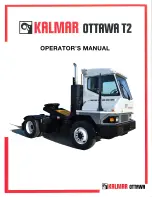
ENGINE-ELECTRICAL 6Y-37
MAINTENANCE AND ADJUSTMENTS
LUBRICATION
The gasoline engine type starting motors have graphite
and oil impregnated bronze bearings and therefore re
quire no periodic lubrication between major overhauls.
The V
-6
Diesel engine type motors have pipe plug oilers
and should have
8-10
drops of light engine oil every
5000 miles or every 300 hours of operation.
RESISTANCE CHECKS
Although the starting motor cannot be checked against
specifications on the car, a check can be made for ex
cessive resistance in the starting circuit. Place a volt
meter across points in the cranking circuit as outlined
below and observe the reading with the starting switch
closed and the motor cranking (distributor primary lead
grounded to prevent engine firing).
1. From battery positive post To solenoid battery
terminal.
2. From battery negative post To starting motor
housing.
3. From solenoid battery terminal To solenoid motor
terminal.
If voltage drop in any of above check exceeds 0.2 volts,
excessive resistance is indicated in that portion of start
ing circuit and the cause of the excessive resistance
could be located and corrected in order to obtain maxi
mum efficiency in the circuit.
CA U TIO N :
Do not operate the starting motor
continuously for more than 30 seconds to avoid
overheating.
When the solenoid fails to pull in, the trouble may be
due to excessive boltage drop in the solenoid control
circuit. To check for this condition, close the starting
switch and measure the voltage drop between the BAT
TERY terminal of the solenoid and the SWITCH (S)
terminal of the solenoid.
1. If this voltage drop exceeds 3.5 volts, excessive re
sistance in the solenoid control circuit is indicated
and should be corrected.
2. If the voltage drop does not exceed 3.5 volts and the
solenoid does not pull in, measure the voltage avail
able at the SWITCH terminal of the solenoid.
3. If the solenoid does not feel warm, it should pull in
whenever the voltage available at the SWITCH ter
minal is 7.7 volts or more. When the solenoid feels
warm, it will require a somewhat higher voltage to
pull in.
STARTING MOTOR AND SOLENOID CHECK
The following checks may be made if the specific
gravity of the battery is 1.215 or higher.
1. If the solenoid does not pull in, measure the voltage
between the switch (S) terminal of the solenoid and
ground with the starting switch closed.
C A U TIO N :
If the solenoid feels warm, allow to
cool before checking.
If the voltage is less than 7.7 volts, check for ex
cessive resistance in the solenoid control circuit. If
the voltage exceeds 7.7 volts, remove the starting
motor and check (
1
) solenoid current draw, (
2
) start
ing motor pinion clearance, and (3) freedom of shift
lever linkage.
2. If the solenoid "chatters” but does not hold in, check
the solenoid for an open "hold-in” winding. When
ever it is necessary to replace a starting mo
tor solenoid, always check starting motor pinion
clearance.
3. If motor engages but does not crank or cranks slow
ly, check for excessive resistance in the external
starting circuit, trouble within the starting motor, or
excessive engine resistance to cranking.
SERVICE OPERATIONS
STARTER MOTOR
Removal and Installation (Fig. 4s)
The following procedure is a general guide for all
vehicles and will vary slightly depending on the truck
series and model.
1. Disconnect battery ground cable at the battery.
2. Disconnect engine wiring harness and battery leads
at solenoid terminals.
3. Remove starter mounting bolts and retaining nuts
and disengage starter assembly from the flywheel
housing.
4. Position starter motor assembly to the flywheel
housing and install the mounting bolts and retaining
nuts.
Torque the mounting bolts 25 - 35 ft. lbs.
5. Connect all wiring leads at the solenoid terminals.
6
. Connect the battery ground cable and check operation
of the unit.
F ig . 4s—Starter Mounting and Solenoid Connections
CHEVROLET TRUCK SERVICE MANUAL
Summary of Contents for 10 Series 1968
Page 1: ...ST 1 3 3 SB...
Page 3: ...w w...
Page 52: ...HEATER AND AIR CONDITIONING 1A 21 Fig 32 Charging Schematic CHEVROLET TRUCK SERVICE MANUAL...
Page 67: ......
Page 128: ...BODY IB 61 Fig 135 A uxiliary Seat CHEVROLET TRUCK SERVICE MANUAL...
Page 132: ...Fig 4 1 0 3 0 Series Truck Frame...
Page 133: ...Fig 5 4 0 6 0 Single A xle Truck Frame E x c Tilt Cab...
Page 135: ...Fig 7 4 0 6 0 Series Tilt Cab Truck Frames...
Page 139: ...w...
Page 169: ...fit w...
Page 233: ...I...
Page 248: ...BRAKES 5 15 TD 50 60 Fig 26 Parking Brake Cables T Models CHEVROLET TRUCK SERVICE MANUAL...
Page 347: ......
Page 389: ......
Page 393: ......
Page 411: ...ENGINE FUEL 6M 18 Fig 18A V 8 Typical CHEVROLET TRUCK SERVICE MANUAL...
Page 525: ......
Page 551: ......
Page 583: ...CHASSIS SHEET METAL 11 12 Fig 20 Designation and Name Plate CHEVROLET TRUCK SERVICE MANUAL...
Page 587: ...ELECTRICAL BODY AND CHASSIS 12 2 Fig 1 Fuse Panel CHEVROLET TRUCK SERVICE MANUAL...
Page 611: ...r ELECTRICAL BODY AND CHASSIS 12 26 9 CHEVROLET TRUCK SERVICE MANUAL...
Page 663: ......
Page 686: ...w...
Page 698: ...SPECIFICATIONS 12 ENGINE TORQUES CHEVROLET TRUCK SERVICE MANUAL...
Page 713: ...9...






































